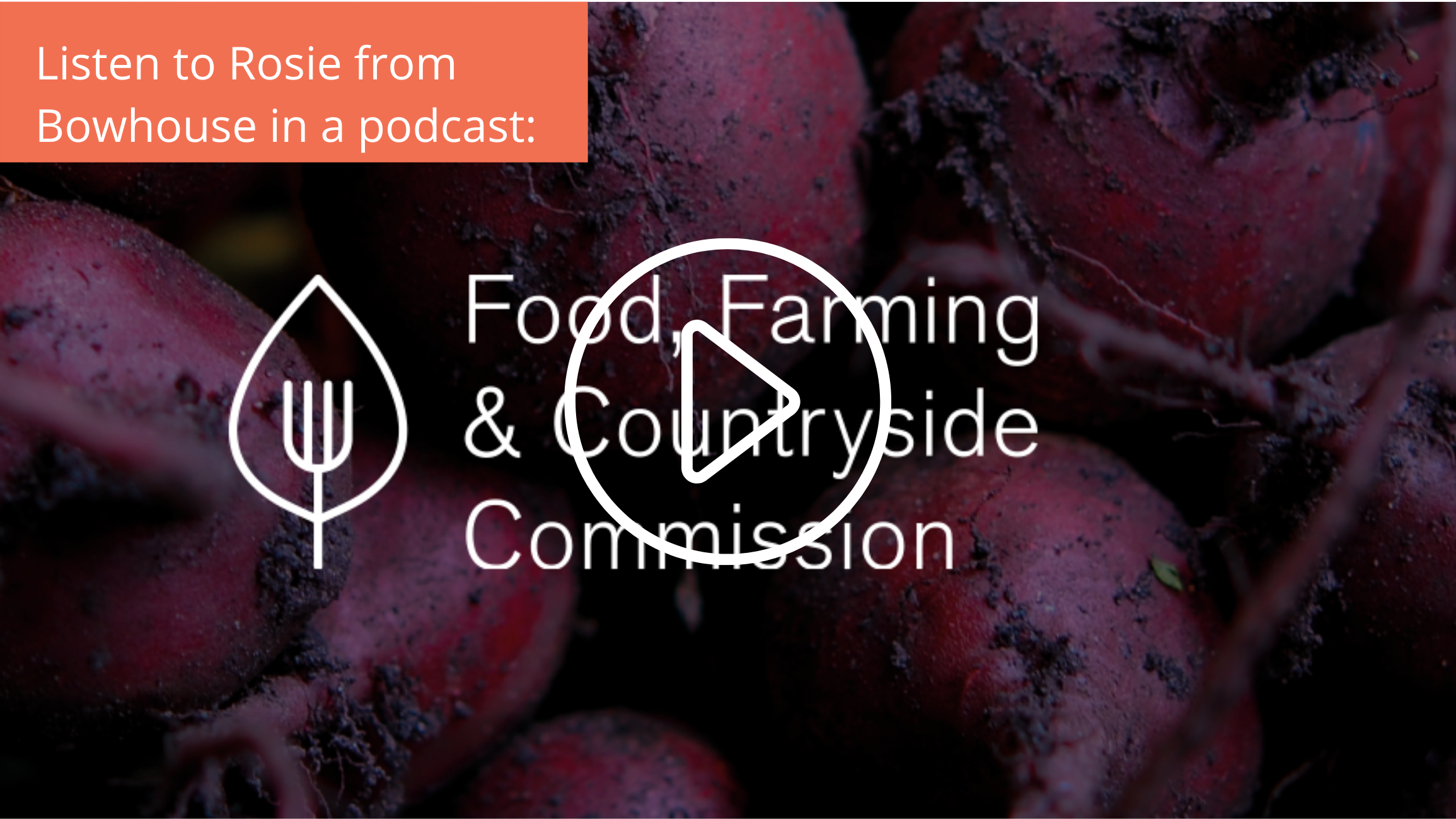Case Studies
Bowhouse Link
Key Facts
You should be able to eat the food that is grown locally and which you pass by on a regular basis.
| Fife, Scotland | |
| Established in | 2017 |
| Market | |
| Company type | Private company |
| N° of employees | 1 FTE, 2 PTE, 5 occasional staff |
Background & values
Bowhouse is part of the Balcaskie estate, an agricultural farm growing cereals; primarily wheat and barley. Balcaskie also rear beef cattle and lamb, and have some forestry.
We are food producers at our core
Bowhouse is in an old converted farm building on the estate and, during normal times, they rent it to food and drink businesses for a monthly market.
Prior to Covid, the market attracted thousands of people and had lots of traders. They have street food, live music and workshops too. To connect the traders with customers more frequently rather than just once a month, they went online with OFN and Bowhouse Link started.
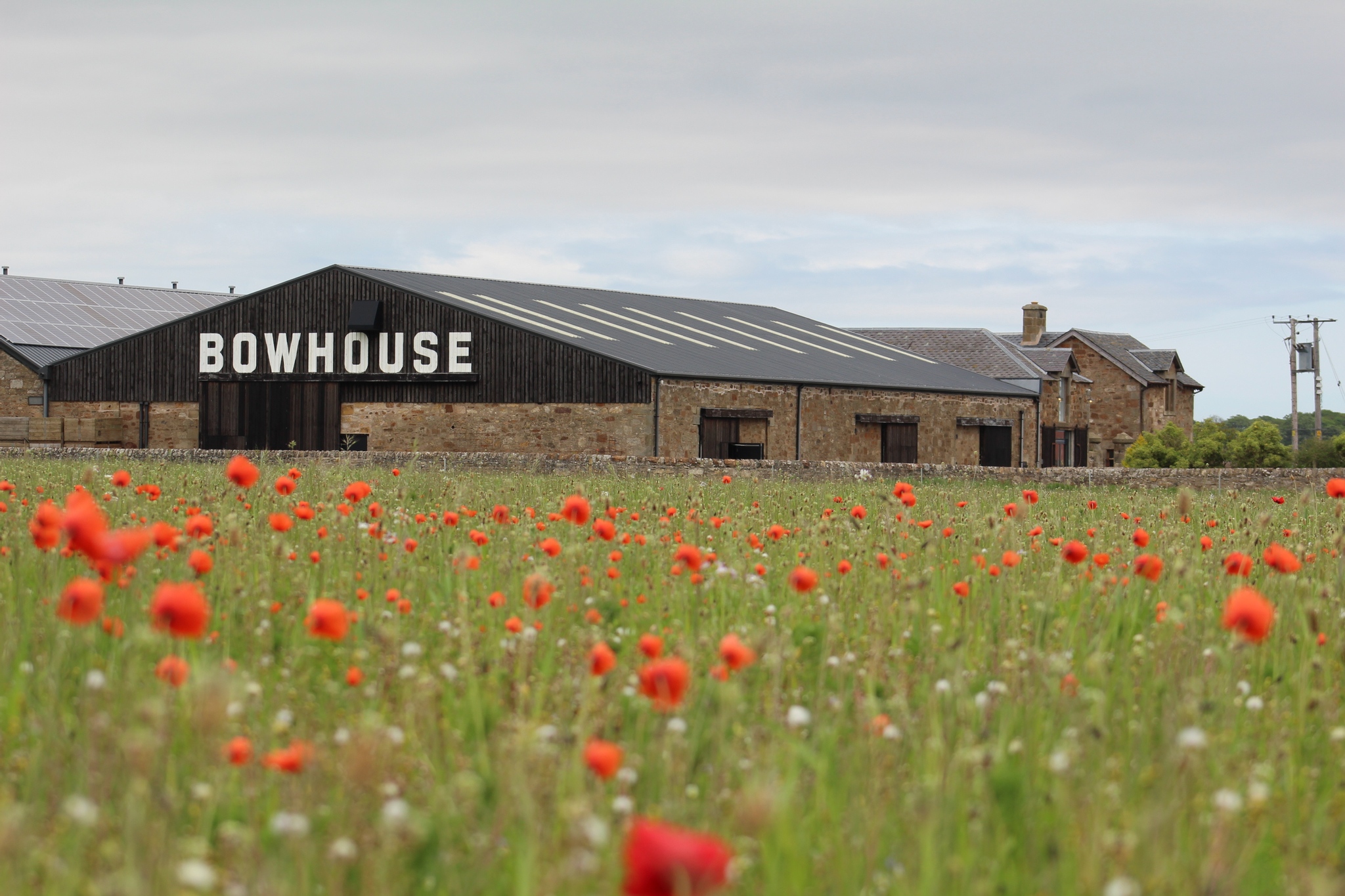
Photo of Bowhouse 11th June 2021, courtesy of Bowhouse Facebook page.
There are lots of layers to why Bowhouse is there, but currently I operate Bowhouse as an umbrella project with a shared vision.
The vision is to connect the local community to local produce. You should be able to eat the food that is grown locally and which you pass by on a regular basis. We’re proud to connect people to produce and take away the middle man. We also support small businesses to gain access to land space and collaboration.
Finding OFN
In the past, Open Food Network was recommended to connect people more regularly with local food and ecommerce was considered a good idea for the market. However, prior to 2020 going online was never a priority and so Bowhouse didn’t get round to making a start on it. When Covid hit, they realised very quickly that all markets and events and traders were losing sales and revenue, so they felt it was their duty to do something about it.
They chose OFN because it is aligned with their values in terms of open source and collaboration and because OFN is like-minded in its approach to food and drink in terms of highlighting good quality local food.
Our reason for working with OFN was to connect people more frequently and highlight benefits of supporting local businesses, such as low food miles.
Being proud
They have lots of things to be proud of. First of all, monthly market weekends in 2019: an average footfall of 5000-5500 people came through the door and traders were doing really well. There were workshops where kids and adults were learning about food and drink and getting hands on and finding out about products. The Christmas order cycle in 2020 was a proud moment, as they managed to send over 100 orders out in a day to customers. Receiving great feedback from customers and winning awards such as the Rural Diversification Award in 2020.
Biggest struggles
They have a brilliant pool of traders in Scotland but are quite envious of what is happening in the rest of the UK, due to red tape in Scotland. It would also be nice to accessa higher population density: there are logistical challenges for deliveries as well as getting people to the market.
Opportunities
COVID-19 has changed how people look at us.
People used to see Bowhouse as just a monthly market, but now they are more interested in the producers that are present all the time. Bowhouse doesn’t want to be seen as a single experience but as a year-round, regular source of local food.

Photo of produce on offer at Bowhouse Link, courtesy of Bowhouse.
Governance
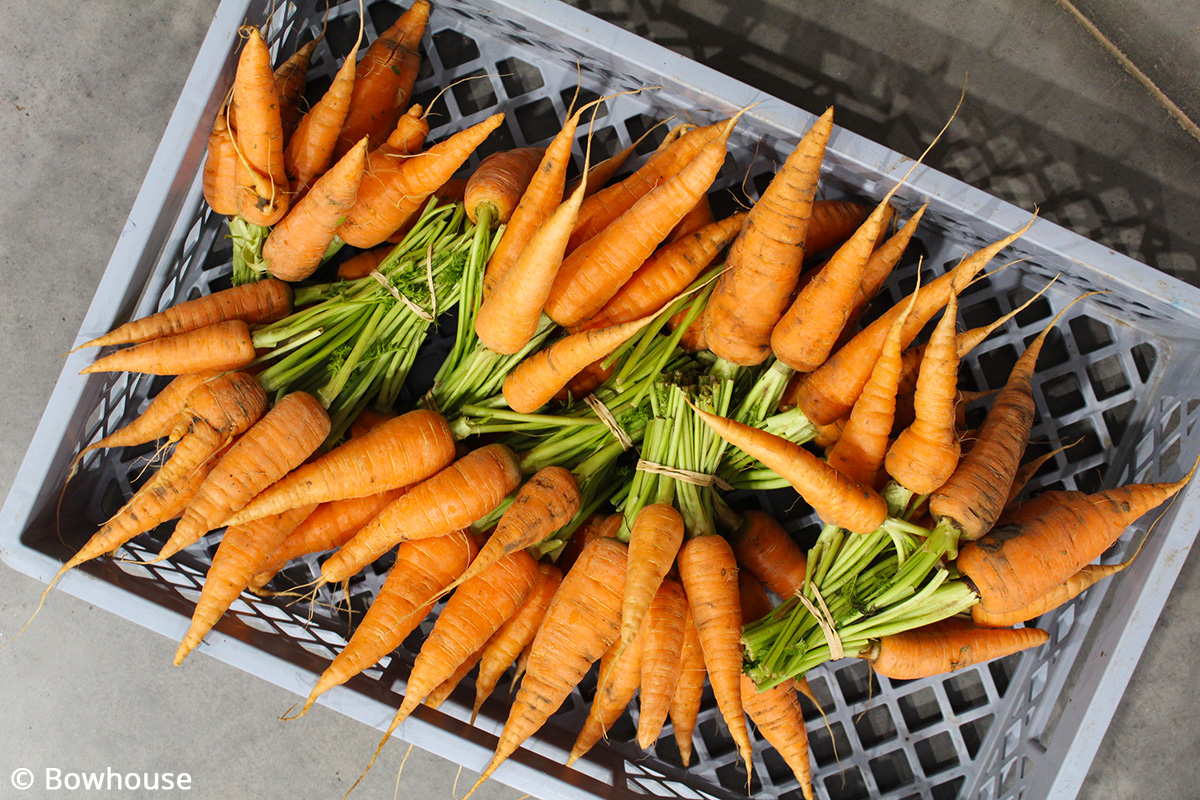
Photo courtesy of Bowhouse.
Both the owner, Toby Anstruther and the estate director, Sam Parsons are very involved. Rosie Jack, the interviewee, is more involved in day to day decisions, but they all work closely on the bigger decisions.
We try not to hide behind a keyboard.
The approach to conflict resolution is simple. They always try to be as open and transparent as possible for all aspects of the business. Any conflict is dealt with by being direct and hearing both sides and trying to resolve issues either face to face or a phone call.
On social media, what they do is just give reasons and beliefs. If any conflict arises, they approach it openly and listen to other points of view.
Logistics
Order cycles
Bowhouse has a simple order cycle model: the shop opens at 10 am on Monday and shuts at 1 pm on Wednesday every week. They notify traders on Wednesday afternoon. The admin team then creates delivery routes using the mapping software Circuit for Teams. The delivery packing sheets are printed off on Thursday morning and the stock arrives from Friday morning. They start picking and packing at 8 am on Saturday so that all orders leave the building at 1 pm.
Holding stock
They hold a little stock of non-perishable goods. This includes produce from some beer and jam producers who are a little further away. Holding stock for producers is not something they encourage as most are local.
Handling food waste
There is no food waste as traders know exactly what to harvest or prepare. So, as long as the pick and pack goes right, there is no waste whatsoever.
For recycling they work closely with waste disposal people and try to reduce waste. Any big food waste from the brewery either goes to the pigs or to their veg plot for compost. Cardboard also goes to the veg plot for raised beds. They are really conscious about reducing waste and work closely with Zero Waste Scotland.
Monday
10 am order cycle opens.
Wednesday
1 pm order cycle closes.
Notify producers.
Create delivery routes.
Thursday
Print delivery packing sheets.
Friday
Stock arrives.
Saturday
8 am start picking and packing.
1 pm last order leaves Bowhouse for delivery.
Waste generated by their weekend market events is more difficult as customers can be untidy and use wrong bins. In 2020 they had planned to become single-use-plastic free by having a horsebox with a dishwasher and everyone to hire plates and cutlery. This plan was put on hold due to the pandemic.
Supplier relationships
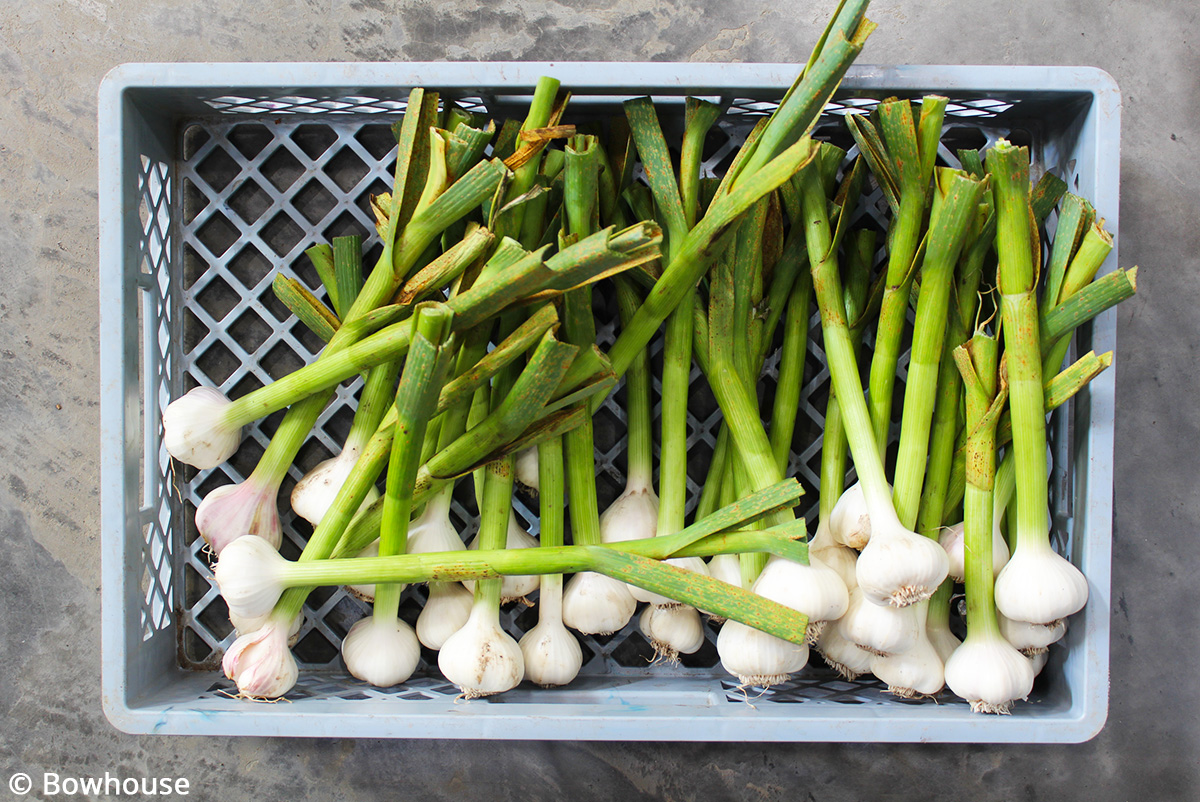
Photo courtesy of Bowhouse.
Prior to the COVID-19 pandemic they already had a relationship of mutual trust with traders. When they went online they could build on these relationships.
Choosing producers
First of all, they ask a series of questions as part of the application, including the backstory and origins of the product. They don’t have any traders who buy from someone else; it’s all homegrown produce. After asking the questions, they have conversations to find out more about them as a person. Another criteria for choosing is trying to keep a good variety of products.
Producers selling elsewhere
Some of their producers sell through their own Shopify stores, which has caused a little bit of issues with stock, mainly at Christmas. Bowhouse makes it clear with producers that they need to guarantee stock if they put it on the OFN platform. However, sometimes product stock levels are not maintained correctly by suppliers. On these occasions, Bowhouse has to refund customers. During the process of reimbursing for missing products, Bowhouse explains the reason for the non-delivery and customers tend to be very understanding. The process helps to educate people on seasonal produce.

Photo courtesy of Bowhouse.
Staying in contact with producers & managing conflict
Generally, Bowhouse send an email with updates or contact them over the phone. Bowhouse are developing a notice board through a traders portal on their website to communicate with traders, so that any new documents or policies will go there. But for now this communication is via emails.
As for managing conflict; normally issues are resolved with a phone call. Having good relationships and friendships with the traders really helps. Bowhouse are always very honest about what the problem is, so things very rarely escalate. Occasionally things get muddled as they manage lots of businesses but they approach things in as friendly a way as possible.
Tools & equipment
Tools
For picking and packing they use trolleys with veg crates that can stack on top of each other.
Anything with wheels really! Such as wheeled stalls for markets.
And also: an electrical drill, a potato box, chopping boards (useful to create signs), a refrigerated van shared with the butchers, printer and clipboards.
Packing space
The packing space currently is a 40 m x 20 m shed where markets normally take place. There are 6 stalls down one side and 6 down another that have all the stock alphabetically ordered. Food to be refrigerated is in a fridge at the centre. They go through with the pick and pack list. There are cardboard boxes with stickers for deliveries and the other end of the hall is for collections
As a result we walk a lot!
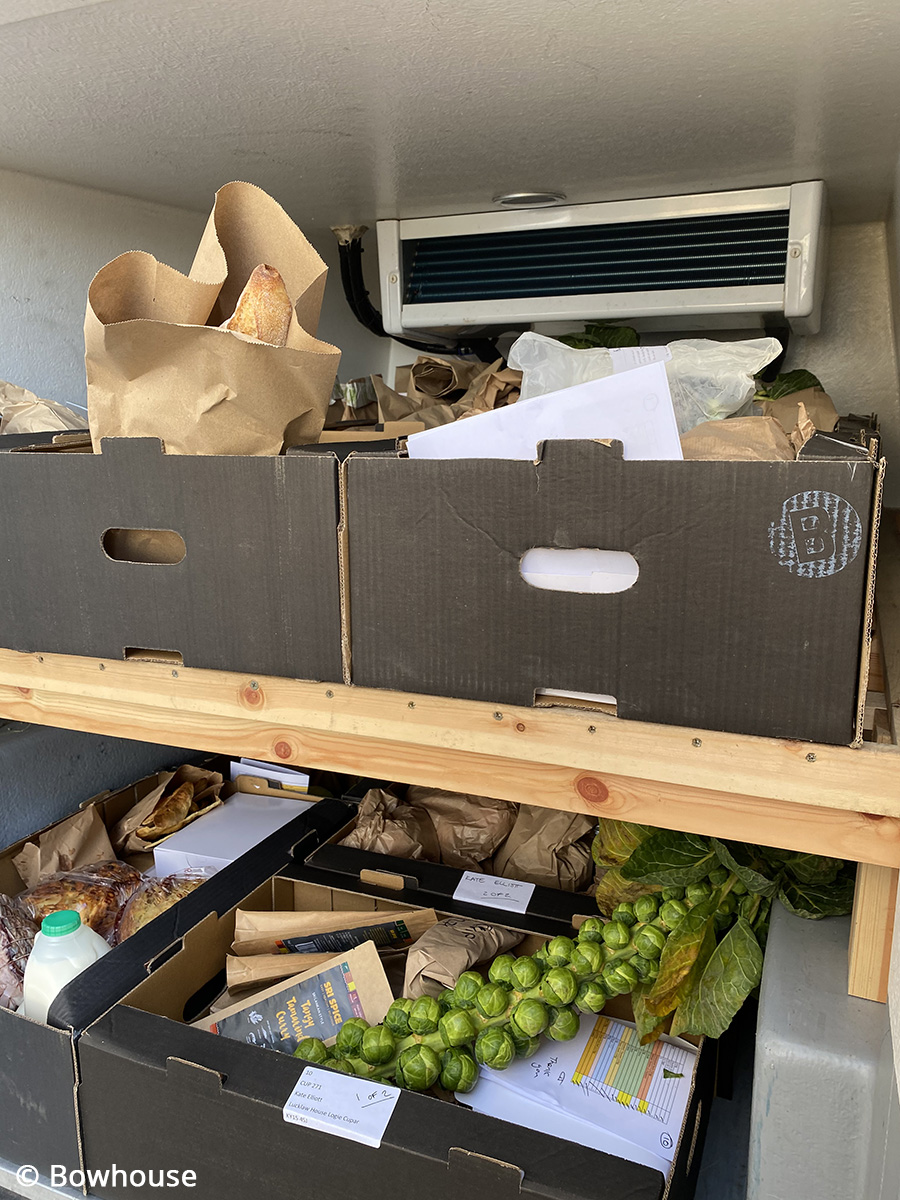
Customer boxes packed into the Bowhouse van, ready for delivery. Photo courtesy of Bowhouse.
The picking and packing is moving to smaller units due to the fact that there will be more weekend events in 2021 so they cannot use the big space. All of this space is part of the assets of Bowhouse company: the estate is privately owned by a trust that has a board of directors who deal with the whole estate.
Software
Aside from OFN they use:
- Excel to edit the OFN customer packing sheets and to change the format from .csv to .xls.
- Team Circuit for delivery route planning.
- Word for printed information sent to customers.
- Social media platforms such as Facebook, Instagram and Twitter.
- Mailchimp for newsletters.
Efficiency of current processes
Overall processes are quite efficient, but sometimes there are issues with Stripe refunds on OFN. Also, sometimes customers get confused as to who is in charge as they receive emails from OFN rather than Bowhouse, so this needs to be made clearer.
Something they spend too much time on is chasing traders for information.
What makes everything easier compared with other platforms is that the shopfront is easy for customers to understand and the payment system is simple. From a back office point of view the process of uploading new products and images and editing products are all really simple.
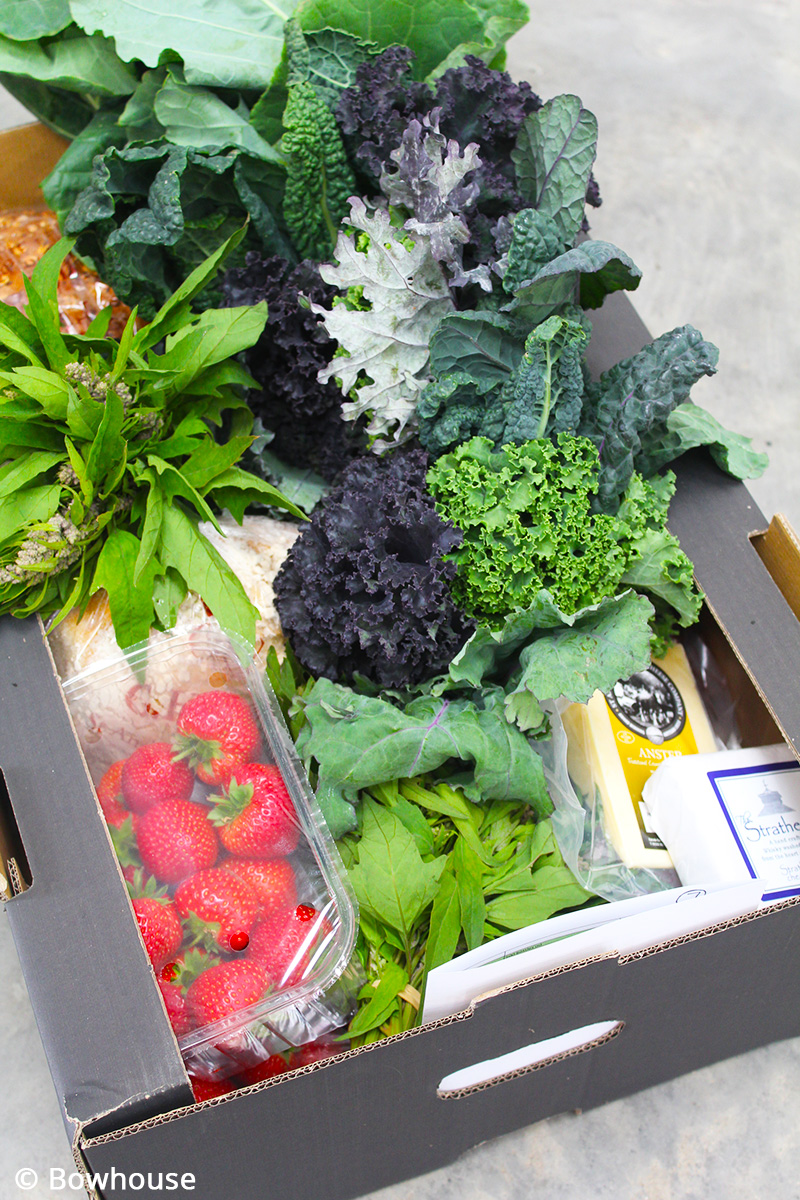
Photo of a typical food order by a Bowhouse shopper, courtesy of Bowhouse.
Business model

Photo courtesy of Bowhouse.
Like many other businesses, as a result of COVID-19, they took a massive hit as their main revenue was market weekends. However, OFN sales ensured that they could keep functioning. Luckily, they had £6000 in the bank at the end of the year, which helped the businesses to survive and then to move forward. They also have support from grant funding.
During the summer we will have to consider whether OFN adds up and whether it’s enough. There’s high uncertainty with customer habits so I’m not sure about what will happen: Will the wave stop? If it does, it’s not considered a failure but we will need to find another way.
80% of the final price goes to producers, OFN takes 2% and the other 18% goes to Bowhouse. The overhead costs are payrolls and assets, such as a large shed. Currently the largest overheads are wages and marketing and any consumable items such as boxes and trolleys.
Employees
The interviewee, Rosie Jack, is the general manager of Bowhouse. There is a part time admin assistant who does Estate admin the rest of her time. They have casual staff that help at events and casual staff to help when deliveries come through. They have recently hired a market assistant. Currently they have one full time, 2 part time and 5 occasional staff that do a variety of tasks. There are no volunteers.
Legal and financial advice
They are part of a bigger business that runs the Estate so they consult the estate’s solicitors and accountants.
Customer relationships
There are three types of customers for the Bowhouse business as a whole:
- Shoppers coming through the door for the market experience. These are the people who pay for the products they purchase either at events or through the OFN platform.
- Stallholders, who are customers of Bowhouse directly, leasing stalls at events and paying for the service in return.
- Tenants at Bowhouse, who pay rent and service charges to Bowhouse which go towards the upkeep of their properties and surroundings.
Bowhouse have also done a demographic survey on Facebook of their followers there.
We try to keep an eye on who is watching us!
Communication
Their main communication channels are:
- A weekly newsletter that goes out when the order cycle opens.
- Social media platforms such as Facebook, Twitter and Instagram.
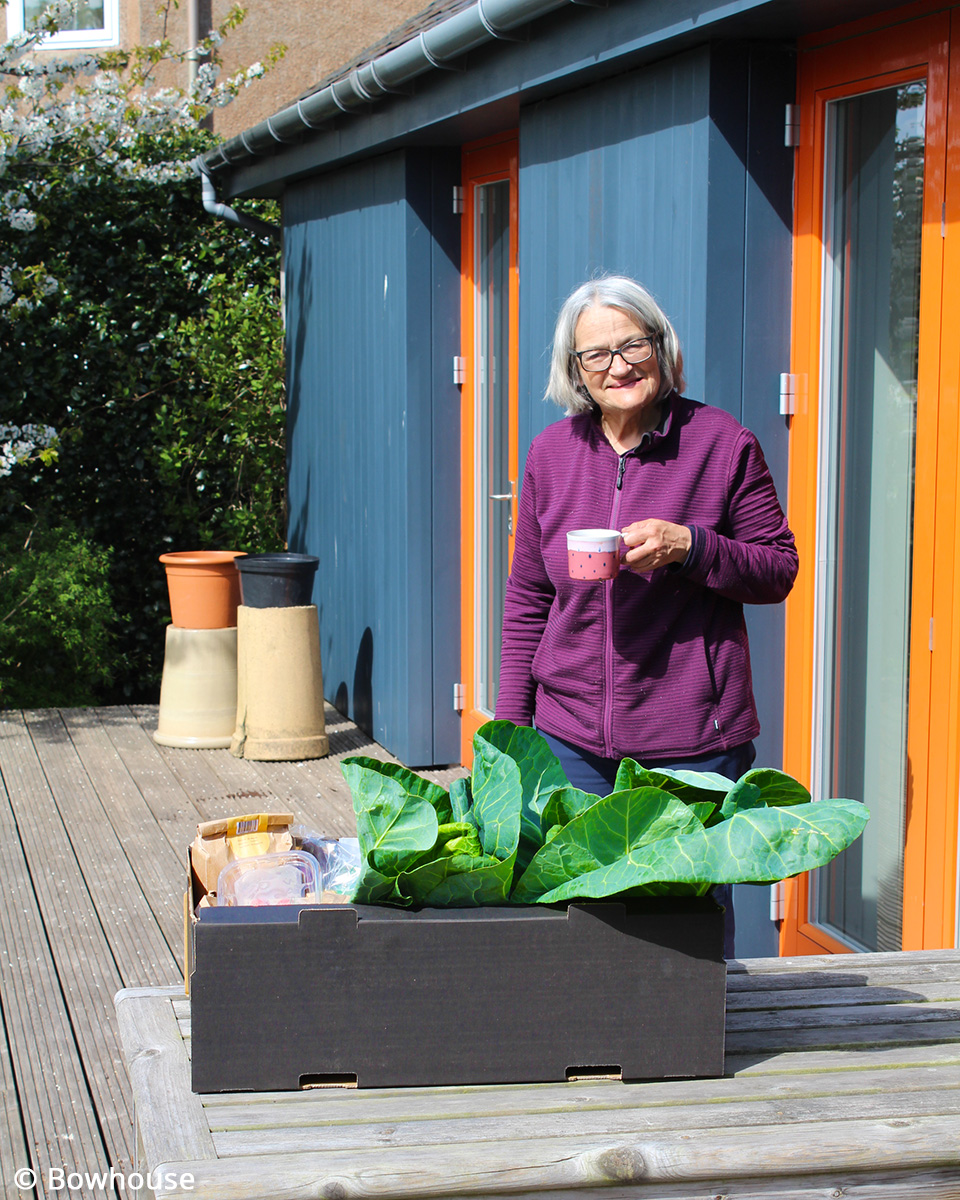
Photo courtesy of Bowhouse.
- A calendar they send everyone with all the market dates.
- The printed press, who the PR team on the Balcaskie Estate are in contact with.
In terms of contacting people who stopped shopping, they thought about approaching lapsed customers- either with a survey or personalised email- but discounted it. Shoppers tend to dislike these type of emails and pushy marketing is not Bowhouse’s style.
Handling complaints
Personalised experience helps to solve problems before they become an issue.
Occasionally something is damaged or out of date. Bowhouse normally try to identify the issue and get in touch with the person who is affected by it and offer a full refund or send a replacement the following week if not perishable.
Community engagement
They work with the Royal Highland Education Trust to bring local primary schools out to farms to teach children about agriculture.
We’re working with them to get children to see various aspects of Bowhouse in the hope to inspire a love of food, drink and agriculture.
They also host other community events such as East Neuk Open Studios and a classical music festival. They aim to help as many charitable events as they can to boost the local economy. They work quite closely with Food From Fife, which brings together food and drink producers from across Fife and anyone in the hospitality industry. They also work with the Soil Association.
Measuring impact
We are trying to get better at it. Measuring the impact is tricky even with the OFN data. But the impact of our community work is harder to measure as quite often it is just an informal friendly hand and how do you record the society benefit for that? I’m not sure.
They work with Business Gateway, a department of Fife Council helping small businesses, and they got funding for a data-gathering project with them. New businesses get a free stall in return for supplying data on the volume of sales and types of customers.
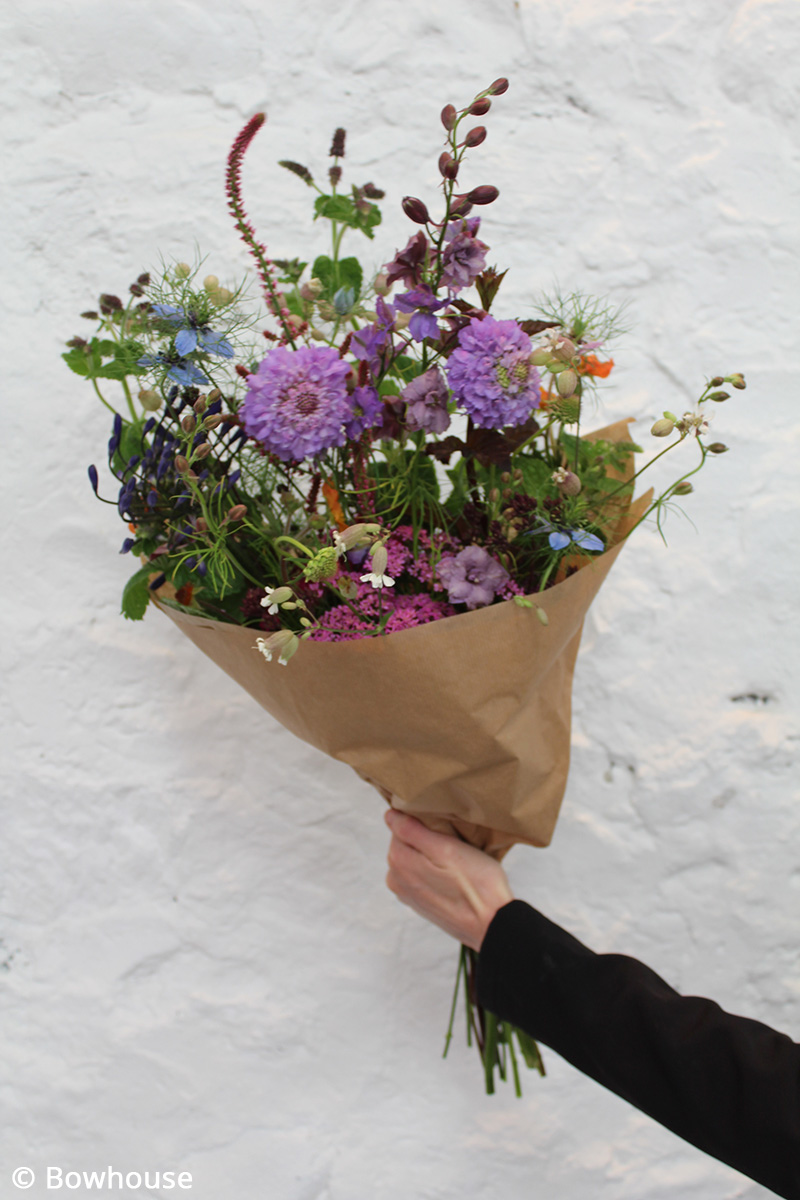
Photo courtesy of Bowhouse.
Follow Bowhouse on social media:
Getting help from OFN
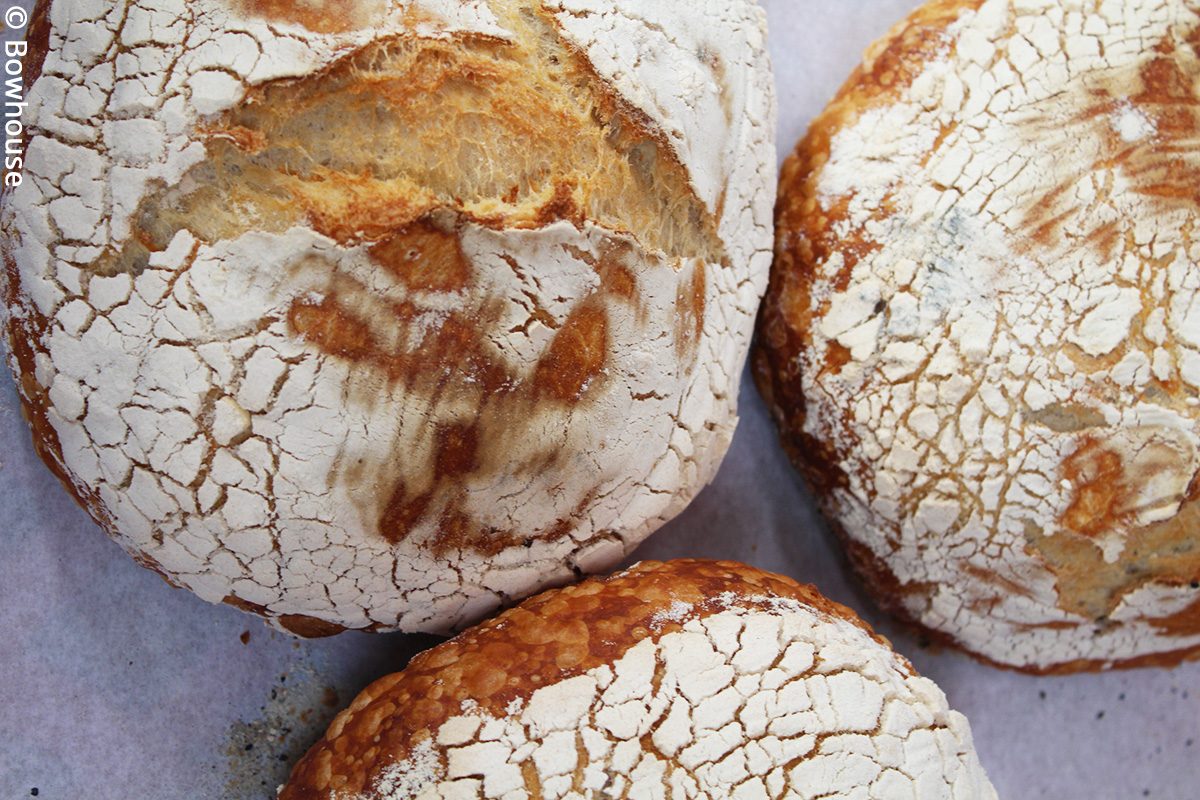
Photo courtesy of Bowhouse.
Everyone is really friendly and quick at dealing with issues. Louise and Lynne are great! The support team has been brilliant. Nick is great and answers all questions!
Collaborating with different hubs is great. I am the only one dealing with OFN and I think that OFN is great.
What could be improved?
They would love to have more back office reports and the ability to input discount codes, as well as a solution to the small problems with tags on products.
Webinar recordings
Click here to watch the recording of our webinar with Rosie from Bowhouse talk about her preparations for Christmas 2020.
Click here to watch the recording of our webinar where Rosie from Bowhouse Link and Rachael from TVFH review their learnings from 2020 Christmas trade.
Listen to a podcast from the Food, Farming and Countryside Commision where Rosie talks about the impact of COVID-19 on people’s perception of local food.
Looking for inspiration to create video content that’s right for social media?
Have a look at some of the videos uploaded to Bowhouse’s Facebook feed here.



